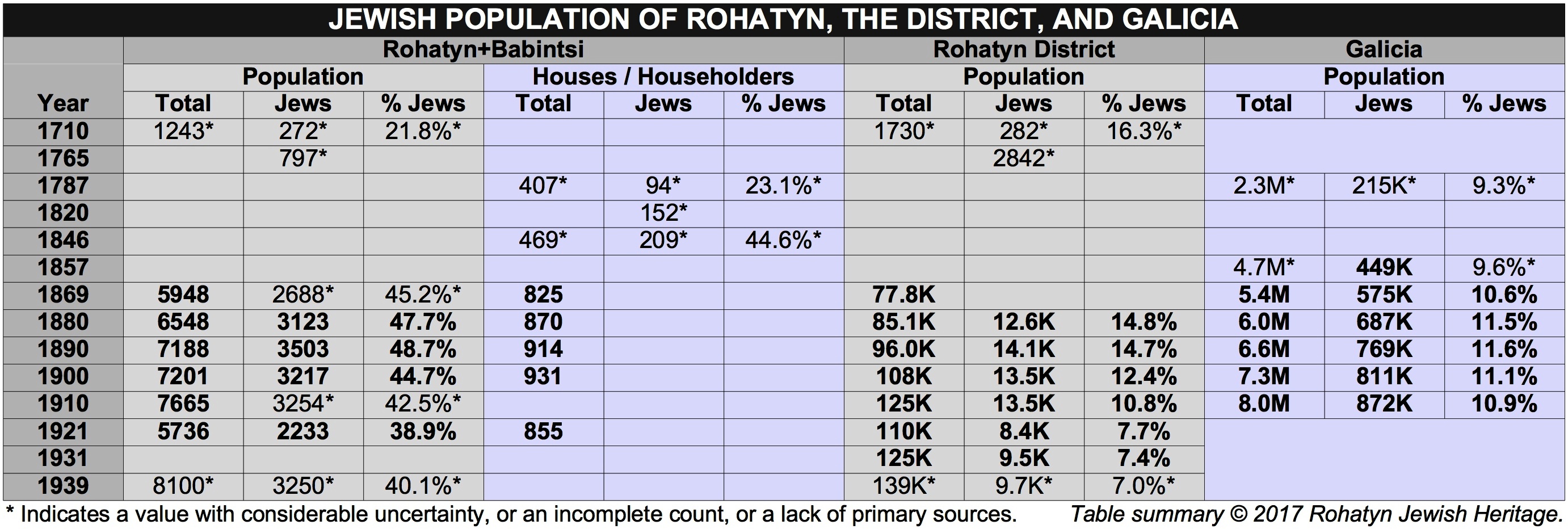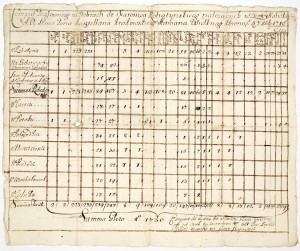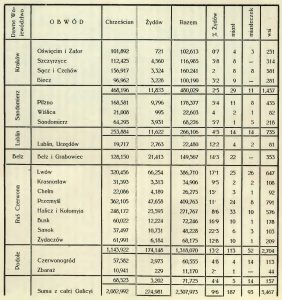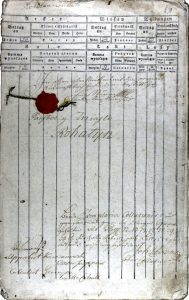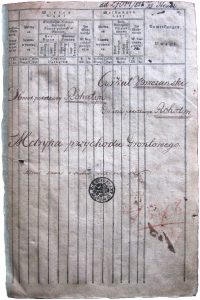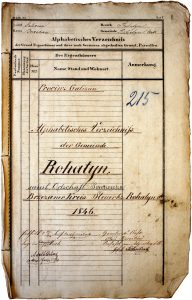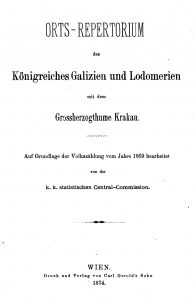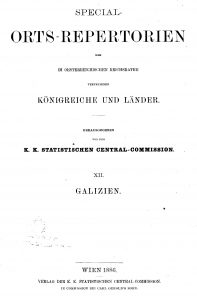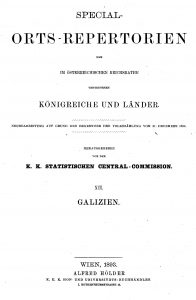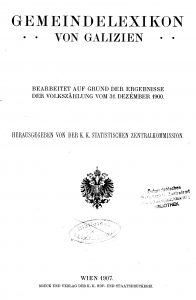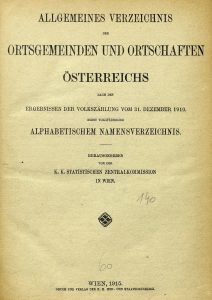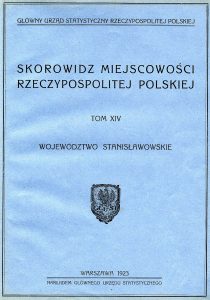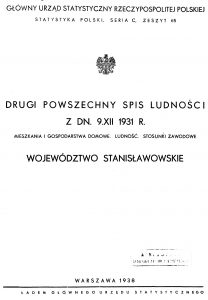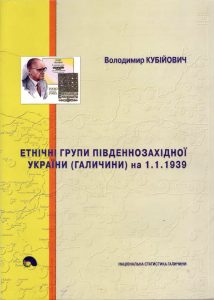![]() Ця сторінка також доступна українською.
Ця сторінка також доступна українською.
Introduction
How many Jews lived in Rohatyn? What percentage of the population were they? Did many Jews live in the nearby towns and villages? Almost everyone with an interest in Rohatyn is curious about these questions, and some may be surprised by the answers. Even we were surprised to see Rohatyn in this list:
[In 1849,] three-quarters of Galicia’s Jews lived in the eastern half of the province, and about 60 percent in small towns and cities. Seven towns – Brody, Belz, Buchach, Rohatyn, Peremyshliany, Deliatyn, and Sokal – were almost entirely Jewish. [Magocsi, A History of Ukraine, 2010, p. 420]
Population censuses were taken in one form or another in Rohatyn over more than two hundred years of Jewish life in the town – at least since 1710 – by the several governments which administered the land during that time. Accurate counts were produced in only some census years, but even the incomplete or apparently inaccurate counts provide some clues to help us understand community life in Rohatyn. Jews were explicitly identified (by religion) in some of the counts, and in others there are ways to approximately identify the Jewish population at least to the household level. An overview of the available population data with a summary in chart, map, and table formats is below, followed by a description with data for each of the years (listed chronologically) in which at least a partial census was taken. Sources are listed with each of the individual censuses. We would welcome additional original sources, plus any related analysis and information others can provide.
Summary and Trends
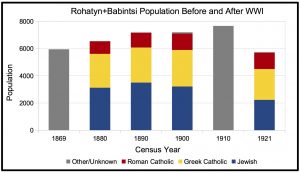
Census data from Austrian and Polish statistics offices. Grey bars indicate total population without religion data. Graphic © 2017 RJH.
Before discussing trends, it is best to start with a few data points to create a sense of scale. In 1880, the first year for which we have both accurate and specific information, Jews made up almost 48% of the combined population of Rohatyn and its adjoining suburb of Babintsi. In 1921, the last year for which we have similar data, and following the deadly disruption of World War I, Jews were almost 40% of the population. More Jews lived near the center of Rohatyn than in the surrounding farmlands or in Babintsi; in 1890, the Jewish population of Rohatyn itself (not counting Babintsi) was just over 60% of the whole. In that same year, Jews made up 14% of the Rohatyn district (as then defined); clearly, many of the other towns in the district had far smaller Jewish populations – but there were exceptions. In that same year of 1890, all of Galicia had 6.6 million citizens, of which 11.6% were Jewish. Outside of these years, we have definite data only before 1500 (no known resident Jews), and after 1950 (no surviving Jewish community).
Throughout the best-counted years between 1880 and 1921, Jews and Ukrainians (or more precisely, Jews and Greek Catholics) made up roughly equal parts of Rohatyn+Babintsi, with Jews the slightly larger group in most years. Poles (Roman Catholics) made up essentially all of the rest, at 15% to 20% of the town.
However, even these few simple numbers require some qualification and explanation. In these summaries we are combining the populations of Rohatyn and Babintsi because they are one town today, and they have been a single entity since at least 1921, according to the Polish census – even though some current residents and many Jewish descendants still speak of the places as distinct. Before 1921 and going back to 1890, according to the Austrian censuses Babintsi was a dependent village of Rohatyn. In 1880 and earlier, Babintsi was a separate village, even having its own dependent hamlets or military camps. Before 1850, it can be hard to tell what settled area is defined as “Rohatyn”; in censuses and other population measures, probably it is the larger town without the adjacent village of Babintsi, and only some records for Babintsi are currently available, which makes comparisons to later years difficult or impossible in several cases.
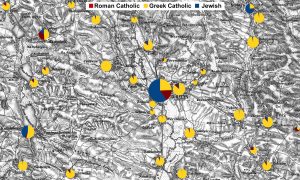
Population detailed by religion for the larger towns and villages around Rohatyn in 1880. The size of each circle corresponds to the relative total population of the settlement. Rohatyn (the largest circle) and Babintsi are at the center of this map. Graphic © 2017 RJH.
Related larger issues appear in district population measures, because the boundaries of the Rohatyn district changed many times, but not always clearly in the existing survey records. District population data is presented here where available, but no attempt has been made to chart trends across time.
Significant caution is required in interpreting the available data for nations (here, meaning ethnic groups) based only on religion or language as listed in the census tables. Not only is there inexact alignment of ethnicity with religion, and very incomplete overlap of language with either ethnicity or religion, but smaller minorities in Rohatyn (Austrians, Germans, and others) are completely overlooked in this type of analysis and lumped with one of the larger three groups. These issues have been covered in a number of analyses of the Austrian and Polish censuses, and in the 1939 retrospective estimate below; we can note the issues but cannot compensate for them here. An important warning comes from Magocsi: In an era when the peasant masses were being asked for the first time to identify themselves with some national label (usually they would still identify themselves by religious affiliation), it is not surprising that difficulties developed with respect to the accuracy of the statistical data. Accuracy would have been a problem even in the most objective environment, which Galicia was not, and the census results caused continual controversy (complete with political repercussions) over the exact number of Ukrainians vs Poles or Greek Catholics vs Roman Catholics.
Finally, it is important to consider the reasons why each of these censuses and other counts were made, which give a clue to possible inherent biases in the surveying and counting methods, and in the final tabulations and analyses. State governments often wanted to know about available military-age men for future conscription, and total numbers of adults or households for taxation; residents often had incentives to avoid the census for the same reasons. Although no census is ever entirely accurate, even with limitations the data here provides useful background to understanding life in Rohatyn over the past centuries.
Much of the raw data included here was first gathered and brought to our attention by our friends Edgar Hauster (for his Czernowitz blog) and Alex Feller (for the Rohatyn District Research Group (RDRG)), from archives and public websites. Links and references to those and other sources are included by survey year below the summary table.
1710
A survey of the population of the administrative district of Rohatyn was tabulated in 1710, probably for purposes of taxation. Counts were made for each town and village of significance, probably excluding children, who were not taxed. The survey divided residents by occupations, perhaps because of varying tax rates for different work; for some occupations, men and women were numbered separately.
Rohatyn was counted separately from Babintsi and from the adjacent estate of Podwinie, but the three settlements were also summed as a unit. Together, the adult population of the three locations was 1243 people, of which 272 (~22%) were Jews (there were no Jews in Babintsi or Podwinie). In Rohatyn alone, the total adult population was an even 1000; the same 272 Jews thus made up ~27% of the town.
Overall the district adult population was 1730, of which 282 (~16%) were Jews. Thus, only 10 Jews lived in the district outside of Rohatyn. Because the table includes only 7 villages other than Rohatyn-Babintsi-Podwinie, either the administrative district was much smaller then than now or some villages were excluded from the survey.
Sources:
- Comput Pogłownego w Dobrach do Starostwa Rohatynskiego nalezacych w Ziemi Halickiej J. O. Jsmci Pana Kasztelana Krakowskiego Hetmana Wielkiego Koronny (Population Summary in the Estates of the Rohatyn District in the Halicz Land of His Grace Kasztelan of Kraców, the Crown’s Great Hetman); 07Dec1710; Biblioteka Książąt Czartoryskich, Kraków, syg. BC 2581. Original research by Alex Feller for the RDRG. See also Rohatyn District Population in 1710, on this website.
1765
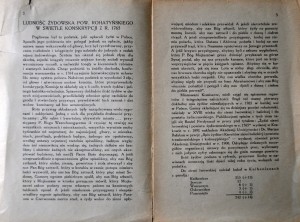
Vol 6 Nr 1 of Kronika Powiatu Rohatyńskiego, at the Stefanyk Library in Lviv, with an article on the Jewish population of Rohatyn powiat.
The first-quarter issue in 1933 of Kronika Powiatu Rohatyńskiego (The Rohatyn County Chronicle) includes an article by Fr. Biesiadecki on a count of Jews in the Rohatyn area in 1765. At the time, all Jews aged 1 and older were taxed; the tax was collected by the kahals with oversight by Jewish and Catholic leaders. The 1765 data was organized by the then-existing districts; for the Kronika article, the author sorted and tabulated the 1765 data for towns and villages in the Rohatyn district as the district was defined in 1933. Because the tax was imposed only on Jews, no information is available for each town’s total population or the resident percentage of Jews.
As reported in the article, in 1710 there were 742 taxable Jews plus an additional 55 un-taxed children under the age of 1, for a total Jewish population of 797 in Rohatyn alone. Babintsi was not listed, and presumably had no resident Jews.
In the district, Pidkamin and Stratyn had the next largest counts of Jews, with 130 and 95, respectively. Overall the district had 1269 Jews. A larger area, including Rohatyn plus kahals in Burshtyn (501), Bukachivtsi (350), Kniahynychi (256), Bilshivtsi (235), and Zhuriv (66), totaled 2842 Jews. This larger figure is used in the summary table above because the district boundary compares better to later censuses.
Sources:
- Kronika Powiatu Rohatyńskiego (The Rohatyn County Chronicle); Vol.6, Nr.1, 1933, p.2~7; “Ludność Żydowska Pow. Rohatyńskiego w Świetle Konskrypcji z r. 1765” (Jewish Population of Rohatyn County in Light of the Count of 1765); Fr. Biesiadecki; Stefanyk Library record Ж-III-36306. Original research by Alex Feller for the RDRG. See also The Jewish population of Rohatyn county from the count dated 1765, on this website.
1787
We have yet to find official publications of census statistics for Rohatyn or Galicia for the almost the entire first century of Austrian administration. However, some numbers must exist, or have existed, based on secondary sources. For Galicia as a whole, it appears that imperfect population measurements were made by the new Austrian administration within the first years of their rule. From YIVO: In 1772, when Galicia was annexed to the Habsburg Empire, there were between 150,000 and 200,000 Jews living there (5–6.5% of the total population). Magocsi reports 144,000 Jews in Galicia in 1776: By the mid-1770s, just after Galicia had become part of the Austrian Empire, Jews comprised 3.1% of the province’s entire population, but 8.7% of the inhabitants of the eastern half of the province.
Majer Balaban, tabulating data from an unsourced 1773 count, lists 224,981 Jews in a total Galician population of 2,307,973; in his table, Jews made up 9.7% of the total (he indicates 9.6%). Balaban points out clear problems in the surveys, which were viewed with significant suspicion by Jews and the imperial administration alike for tax and military conscription reasons. As proof, he also lists the Jewish count for the years 1774 to 1786, in which the apparent population dropped immediately to 171,851 (1774) to a low of 144,200 (1776) and then rose rapidly again to 215,447 (1786).
Lacking information about individuals, we can instead look at counts of households for an indirect measure of the population. Separate from population surveys, the Austrian Empire also attempted to measure and categorize properties (especially land) in order to assess their value throughout Galicia beginning in 1772. A catalog of these cadastral surveys produced by the Central State Historical Archives of the Ukrainian SSR in Lviv in 1965 describes the collection as “a versatile resource” that is nonetheless “little used”. The catalog’s introduction tells an amusing tale of five attempts between 1772 and 1784 to measure and assess properties, each foiled by incompleteness and/or fraud by property owners, or by insufficient manpower allocated by the government. Finally in 1785 an imperial patent set in motion a successful land survey, and in 1788 another patent enforced the count of buildings in the land survey. The survey, named “Josephinian” for the emperor who ordered it, appears to have completed in Rohatyn in 1787, and across Galicia in 1788.
Where records survive, as the archive publication attests, the survey is very valuable for historians of local and regional economies, and for genealogists, because of the detailed listings of property owner names plus the sizes and categories of land and buildings they owned. As a measure of populations, the survey is indirect and difficult to correlate to regular censuses, but general statistics can be extracted for further analysis.
The Rohatyn register does not state whether it includes Babintsi; because it is not named, we assume Babintsi is excluded. The 68 pages of listed and described properties include many numbered “houses” which are not private residential buildings: Catholic and Jewish hospitals, other religious buildings associated with churches and the kahal, schools, and a brickworks. Subtracting the non-residential buildings from the survey, there were about 366 individual houses and manor residences in Rohatyn. 41 of the houses are listed more than once with different owners (who may own parts of the houses or perhaps separate properties in town, or which represent numbering errors in writing or reading); thus there are about 407 “householder” names in the register.
Jews (and others) are not identified as such in the register. A very rough count of the Jewish householders can be made by sorting given names and surnames or patronymics using common guidelines; from this an approximate number of Jewish householders is 94. Thus the portion of Rohatyn’s householders in 1787 is (very) approximately 23%.
We will not try to extrapolate this rough calculation further to an estimate of the town’s total and Jewish populations; lacking any information about average family sizes within households, other residents, and the differences between the populations of different faiths, the result would be worse than a guess.
Sources:
- A History of Ukraine: The Land and Its Peoples; Paul Robert Magocsi; University of Toronto Press; 2nd Edition, Toronto, 2010; p. 419.
- The Galitzianer; Vol.23, Nr.1 (March 2016), p.11~14; “Early Galician Population Surveys”; Andrew Zalewski.
- Central State Historical Archives of Ukraine in Lviv (TsDIAL), record 19.9.263. Original research by Andrew Zalewski for the RDRG.
- Dzieje Żydow w Galicyi i Rzeczypospolitej Krakowskiej 1772~1868 (History of the Jews in Galicia and the Commonwealth of Kraków 1772~1868); Majer Balaban; Nakładem Księgarni Polskiej B. Połonieckiego; Warsaw, 1914; p.7~9, 20~21.
- Йосифінська (1785~1788) і Францисканська (1819~1820) Метрики (Josephine 1785~1788 and Franciscan 1819~1820 Metrics – First Land Cadasters of Galicia Including Population Data); Ya. Zakharchyshyna, ed., with Ya. Pyrozhenko and V. Siverska; Central State Historical Archives of the Ukrainian SSR in Lviv; Kyiv, 1965; p.5~15.
1820
A second property survey was conducted by Austrian authorities in Rohatyn in 1820. Termed the “Franciscan” cadastral survey after Franz I of Austria (who issued the patent ordering an empire-wide survey in 1817), using a new set of instructions for imperial and local surveyors and assessors. The resulting report, which continued into the 1820s, was meant as an update to the 1787 data (both to correct errors and omissions, and to account for changes to property boundaries, buildings, and ownership since the original survey), and for the first time included a comprehensive cadastral mapping effort as well. A map of Rohatyn from the 1820s, if one was created, has not survived, but the property register is complete. As is true for the 1787 survey, the 1820 register includes valuable details about individual properties and individual named property owners, but it also suffers the same limitations for determining the actual population of the town.
Again Babintsi is not mentioned in the register, so we have to assume the village is omitted from the count. Only the first 36 pages of the register were captured for the RDRG, because there were no Jewish names present in the register on later pages, so it is not possible to count the total number of householders. 268 distinct householders were listed on those 36 pages, including only 15 duplicate house numbers (shared houses or house number transcription errors).
Of the 268 named householders, 152 names were recognizably Jewish, a significant increase from the 1787 cadastral survey. Lacking a total house count, it is not possible to calculate the Jewish portion of the property owners. And again, no attempt was made to extrapolate this data to the population of individual Jews.
Sources:
- The Galitzianer; Vol.23, Nr.1 (March 2016), p.11~14; “Early Galician Population Surveys”; Andrew Zalewski.
- Central State Historical Archives of Ukraine in Lviv (TsDIAL), record 20.9.189 p.1~35. Original research by Marla and Jay Osborn for the RDRG.
- Йосифінська (1785~1788) і Францисканська (1819~1820) Метрики (Josephine 1785~1788 and Franciscan 1819~1820 Metrics – First Land Cadasters of Galicia Including Population Data); Ya. Zakharchyshyna, ed., with Ya. Pyrozhenko and V. Siverska; Central State Historical Archives of the Ukrainian SSR in Lviv; Kyiv, 1965; p.5~15.
1846
Cadastral surveys continued in Galicia and the Austrian crownlands through the 19th century and until the collapse of the Empire in World War I. The last known survey of Rohatyn was in 1846; it is complete in Ukrainian archives and fortunately includes a highly detailed first-state cadastral sketch, which allows us to locate property owners in the town (and to correlate house numbers on vital and legal records to the town geography as well). As a field sketch, roads, buildings, waterways, and other town features are wildly out of scale and position, but with digital distortion it is possible to re-position most of the historic features to within about 10m, and the relative locations of buildings etc. are probably quite good.
For analysis of the town’s population, the 1846 cadastral survey suffers the same limitations as the 1787 and 1820 surveys, but the registers are clear and the survey methods were good, so we can make a reasonable estimate of householders. The nearby village of Perenivka (just north of Rohatyn) was included in cadastral survey, but is omitted from our analysis. A small number of house owners resident in nearby villages (Babintsi, Pidhoroddya, Verbylivtsi, Zaluzhya, etc.) are also included in the registers; only Babintsi houses were retained in our analysis. Buildings associated with churches, the kahal, schools, the Austrian administration or military, and with unnamed/unknown owners, are all omitted. All but one of the buildings owned by the local landlord Peter Krasiński were omitted as well, although some second buildings owned by smaller property owners of apparently Polish, Ukrainian, and Jewish ancestry were retained in the analysis.
Of the 469 distinct named householders in this survey, 209 names were recognizably Jewish, an increase from the 1820 cadastral survey. Thus the portion of Rohatyn’s householders in 1846 is (very) approximately 45%. Again, no attempt was made to extrapolate this data to the population of individual Jews.
Sources:
- Central State Historical Archives of Ukraine in Lviv (TsDIAL), records 186.2.21a and 186.2.21b. Original research by Gesher Galicia for the RDRG. Indexing by Alex Feller for the RDRG.
- Central State Historical Archives of Ukraine in Lviv (TsDIAL), map record 186.1.668. Original research by Alex Feller, Jay Osborn, and Marla Raucher Osborn for the RDRG.
1857
Reference is made in several sources about an organized Austrian census survey including Galicia in 1857, but to date we have found no official publications or other records from this survey in archives or libraries, or online. From Himka: There were early, unscientific censuses conducted in Austria in 1785 and 1804, but the first attempt at a scientific census was made in 1850. This attempt was considered unsuccessful, and the census was repeated on 30 October 1857. This time, too, the results were not considered reliable.
Even if unreliable, the data would probably prove interesting, and a useful data point to help bridge the large gap back in time to the 18th century. To date we have original source information only about the Jewish population of Galicia as a whole.
YIVO reports without specific reference that relative to the less than 200,000 Jews estimated for 1772, [b]y 1857, the number had risen to 449,000 (9.6%); that count is confirmed in an 1869 report from the Austrian central statistical commission (448,973; see below). From these values the total population of Galicia in 1857 can be estimated at approximately 4.68 million people.
Sources:
- Galicia and Bukovina: A Research Handbook About Western Ukraine, Late 19th and 20th Centuries; John-Paul Himka; Historic Sites Service, Occasional Paper No. 20; Alberta Culture & Multiculturalism Historical Resources Division, March 1990; Ch.III, “Published Sources to Social and Local History”, A. Statistical Publications, p.53~56.
- Statistik des Judenthums in den im Reichsrathe vertretenen Königreichen und Ländern; Gustav Adolf Schimmer; Vienna, 1873; Freimann-Sammlung Universitätsbibliothek, Goethe Universität, Frankfurt am Main. Original research by Edgar Hauster for http://czernowitz.blogspot.de/.
1869
After a break of more than 150 years, finally in 1869 and under a new crown, a carefully-managed census of the population was taken in Rohatyn (and Galicia, and the Austrian Empire). The imperial statisticians and administrators responded well to the failures of the previous years, organized and trained, and provided the resources necessary to effectively count heads all through their domain. Continuing his review of the Austrian efforts, Himka writes: The first satisfactory census was conducted on 31 December 1869 by the Statistical Central Commission (G Statistiche Central-Commission [after 1900 Zentralkommission]), established in 1863. Especially in regard to the occupational structure of the population, the 1869 census is considered more reliable than the following census, conducted on 31 December 1880.
The census collected demographic data of a variety of types; the imperial statisticians analyzed the data and summarized it in reports and bulletins published over the next decade. At the town and village level, only the number of houses and the total population (with the numbers of males and females) was published.
At the time of this survey, Rohatyn and Babintsi were still completely distinct settlements. In Rohatyn alone, there were 4510 people in 542 houses; Babintsi had 1438 people in 283 houses. Summing the adjacent populations together for purposes of comparison to later surveys, there were were 5948 people and 825 houses. It is interesting to note that Rohatyn’s housing averaged 8.3 people per house, while Babintsi’s was 5.1; that may reflect larger and/or multi-family houses in residential areas around the town square.
In 1869 the district (bezirk) of Rohatyn was large, including more than 100 towns and villages centered on both Rohatyn and Burshtyn. The town of Rohatyn was the largest the district; the smallest was Perenivka with only 28 houses and 132 people. Overall, the district had 77,826 people in 11,998 houses (6.5 people per house).
For Galicia overall, in 1869 the survey found 5.42 million people, in 858 thousand houses (averaging 6.3 people per house), and in 74 bezirke, including Rohatyn’s. The significant population rise from 1857 (almost 16%) suggests the earlier estimate is questionable.
Although the main census report for the 1869 survey did not detail the religious or ethnic composition of Galician towns, a report published in 1873 by Gustav August Schimmer [Österreichisches Biographisches Lexikon], then the director of the Austrian central statistics commission, provided a count of Jewish populations in organized Jewish communities at the town/village level, together with other information about features of the communities. This distinct count made around the time of the 1869 census was based on harmonized data-collection forms developed by a synod of Jewish leaders from Germany, Switzerland, and Austria-Hungary.
For the town of Rohatyn, a total of 2613 Jews were counted. We know that this number excludes Babintsi, from comparative data included in another separate report for 1880 (see below). Based on population trends in 1869, 1880, and 1890, we can estimate the number of Jews in Babintsi in 1869 at around 75, making the total Jewish population in the combined settlement about 2688; this estimate is included in the table in the summary section above.
The special survey also enumerated for Rohatyn: one registered Jewish community, one rabbi (likely the community leader), five teachers (Lehrer, probably working as rabbis), in five synagogues owned by the community and another two in rented buildings; a cemetery owned by the community is also counted. Curiously for a Jewish community of this size, the report indicates no cantors or shochets, and no Jewish schools, hospitals, burial societies, or bath houses, an absence which conflicts with markings on the 1846 cadastral map of Rohatyn. We suppose that some of these functions and facilities were privately funded and so did not register as community assets.
District-level data is not available, but eight individual towns in the Rohatyn district are counted. Jewish schools are noted in both Zhuriv and Kniahynychi; Stratyn had three synagogues for only 284 Jews, but based on later censuses we know that the Jewish population there was rising very rapidly in 1869.
This special report also indicates the total number of Jews in the major lands of the Austrian Empire. Galicia counted 575,433 Jews in 1869, making up 10.6% of the kingdom (the same table also provides as reference the count from the imperfect 1857 census, see above). Thus the report specifically highlights the Jewish proportion of Galicia, at 1 in 9 citizens, as the highest in the Empire. Incorporating data from almost 30 lands outside of Austrian control, including nearly all of Europe, Scandinavia, and North America, the report’s data indicates that in the years around 1869 only Russian Poland had a higher concentration of Jews (1 in 7), although “European Russia” had more than three times the number of Jews (1.8 million).
Sources:
- Bukovina & Galicia Censuses for the Years 1869, 1880, 1890, 1900. Original research by Edgar Hauster for http://czernowitz.blogspot.de/.
- Statistik des Judenthums in den im Reichsrathe vertretenen Königreichen und Ländern; Gustav Adolf Schimmer; Vienna, 1873; Freimann-Sammlung Universitätsbibliothek, Goethe Universität, Frankfurt am Main. Original research by Edgar Hauster for http://czernowitz.blogspot.de/.
- Galicia and Bukovina: A Research Handbook About Western Ukraine, Late 19th and 20th Centuries; John-Paul Himka; Historic Sites Service, Occasional Paper No. 20; Alberta Culture & Multiculturalism Historical Resources Division, March 1990; Ch.III, “Published Sources to Social and Local History”, A. Statistical Publications, p.53~56.
1880
Although some of the data for detailed demographic categories may have lost accuracy in the 1880 census, overall the quality was still very good. A new feature of the 1880 survey was the collection of count data on the population’s religious affiliations and languages. Because of rather strong alignment at the time between religion and ethnicity in eastern Galicia, these data are also somewhat indicative of the relative populations of the different communities. The chart which begins the overall summary and trends discussion at the top of this page shows a first bar in 1880 depicting this data. The language categories included only German, Polish, and Rusyn, omitting both Yiddish and Hebrew, and anyway the Jewish citizens may have answered language questions in any of several ways depending on their level of assimilation.
At the time of this survey, Babintsi was still a separate village, even having its own dependent hamlets or military camps (named in German language as Lasowe and Werbiane) with a combined population of 39. In total, Babintsi had 291 houses and 1447 people, of whom 88 (6.1%) were recorded as Jewish. In Rohatyn, its 579 houses were home to 5101 people, of whom 3035 were Jewish, a proportion of 59.5%. Taken together, Rohatyn and Babintsi had 3123 Jews, making up 47.7% of the total population of 6548 people; there were 870 houses in total.
As for 1869, the Rohatyn district was large, but in 1880 its towns and villages were more clearly divided between the nearly-equal Rohatyn and Burshtyn Gerichtes-Bezirke (sub-districts). In the Rohatyn-centered portion, there were 7046 houses with 40,728 people, of whom 5832 (14.3%) were Jewish. Combined with the Burshtyn-centered portion, the district overall had 14,111 houses and 85,132 people, including 12,569 Jews (14.8%).
By 1880, Galicia had reached a total population of just under 6.0 million people, a rise of almost exactly 10%. Jews made up 687 thousand of the Galitzianers, or 11.5% of the total. The population lived in 961 thousand houses, still averaging 6.2 people per house.
In 1881, well before the full statistics from the census had been assembled and published, the director of the central statistical commission (Gustav Adolf Schimmer again, as in 1869) produced a special report for the monthly journal of the commission, entitled “The Jews in Austria”. His focus was the “statistically interesting” aspect of the Jewish portion of the Empire’s population, in particular its variation and its growth, which contrasted sharply with the trends for other confessions. The director highlighted the reason for his interest: the Empire’s Jewish population had increased dramatically between 1850 and 1880 – more than double over 30 years, or 2.5%/year – while the non-Jewish population had increased by only 24% in the same period. This was also a sharp increase over the Jewish population growth rate through the previous 20 years beginning in 1830 (1.5%/year), and thus indicated a significant demographic change.
Galicia was particularly studied. Although no strong conclusions were made about the reasons for the large average growth rate, tremendous variety in rates were noted from small negative values (decreases, in a few districts) to huge growth (more than 125%) in other places since the prior census just 11 years earlier. Both the growth rate and the current percentage of Jews in 28 towns in 1880 was quantified in the report; Rohatyn (without Babintsi) is listed in the middle of towns ranging from 28% Jewish (Lemberg/Lviv) to 91% Jewish (Vyzhnytsia). Many other towns in eastern Galicia figure in the table; Rohatyn’s Jewish count rise of 372 people between 1869 and 1880 looks quite modest compared to some, for example Boryslav, which rose by ten times that number of Jews in the same period.
Elsewhere the tables show another interesting change: From 1869 to 1880, the number of Jews in Galicia serving in the Austrian military quadrupled, while other faiths in the military rose by less than 15%. In 1880, 1 in 16 military men in Galicia were Jewish.
Sources:
- Bukovina & Galicia Censuses for the Years 1869, 1880, 1890, 1900. Original research by Edgar Hauster for http://czernowitz.blogspot.de/.
- Die Juden in Oesterreich nach der Zählung vom 31 December 1880; Gustav Adolf Schimmer; Statistische Monatschrift, Vol VII, p.489~503; Austria Statistische Zentralkommission; Vienna, 1881; Internet Archive. Original research by Edgar Hauster for http://czernowitz.blogspot.de/.
1890
The Austrian administrators, their local representatives, and the imperial statisticians continued to learn from each census, progressing their methods and the data quality over time. From Himka: The censuses of 31 December 1890, 31 December 1900 and 31 December 1910 used an improved method of gathering data and asked increasingly more detailed questions. For example, while the 1880 census recorded 28 occupational categories, the 1890 census recorded 39, the 1900 census 182, and the 1910 census 203.
The survey results for the 1890 census at town and village level were analyzed and formatted very similarly to the 1880 summaries. In 1890, Babintsi was still counted separately, but now it was reported as a dependent village of Rohatyn. Babintsi’s total population was recorded as 1572 people, of whom 93 were Jewish (5.9%); 291 houses were counted. In the town of Rohatyn alone, there were 623 houses, in which 5616 people lived, including 3410 Jews (60.7%). In Rohatyn and Babintsi together, the surveyors counted 914 houses with 7188 people, including 3503 Jews (48.7%). Overall, the population of Rohatyn+Babintsi had risen by almost 10%; the Jewish population had risen by 12%.
The Rohatyn district retained its clear and equal division between Rohatyn and Burshtyn centers. The Rohatyn-centric portion contained 7268 houses and 46,550 people, of whom 6492 were Jewish (13.9%). Together with the Burshtyn-centric portion, there were 14690 houses and 95,975 people, including 14,149 Jews (14.7%). As for 1880, in 1890 almost one in seven residents of the Rohatyn district was Jewish.
Similar growth was seen in Galicia as a whole: 6.6 million people were counted in 1890, including 769 thousand Jews (11.6%), altogether living in 1.03 million houses. Thus the total population had again risen by almost exactly 10%, but now the Jewish population rose by almost 12%.
Sources:
- Bukovina & Galicia Censuses for the Years 1869, 1880, 1890, 1900, and Deutsche Digitale Bibliotek. Original research by Edgar Hauster for http://czernowitz.blogspot.de/.
- Galicia and Bukovina: A Research Handbook About Western Ukraine, Late 19th and 20th Centuries; John-Paul Himka; Historic Sites Service, Occasional Paper No. 20; Alberta Culture & Multiculturalism Historical Resources Division, March 1990; Ch.III, “Published Sources to Social and Local History”, A. Statistical Publications, p.53~56.
1900
The dawn of the 20th century brought another population census and a variety of new statistics to present in the summary report at town and village level. In addition to the prior counts of houses, people (males and females), confessions, and languages, the counts expanded to include the number of hectares within the cadastral area, as well as the number of horses, cattle, sheep, and pigs. The taxable land was further detailed by hectares of arable fields, grassland, and forest. Additional notes on institutions categorized and counted the number of schools, religious buildings, military lodgings, notaries and lawyers, hospitals, doctors and pharmacies, courts, and a variety of administrative services. These additional details give dimension to the plain population counts.
Rohatyn and Babintsi were again counted separately but reported together. A third category listed and summed with Rohatyn was a local military station, which included 131 soldiers – 7 of them Jewish, and 46 of them speaking first languages other than German, Polish, or Rusyn, reflecting the diversity of the Austrian military. In 1900, the count in Babintsi totaled 1672 people, of whom 74 were Jewish (4.4%), in 294 houses. Rohatyn alone had 5520 people, including 3143 Jews (56.9%), in 637 houses. Overall, and including the military station, the Rohatyn+Babintsi settlement reported 7201 people, including 3217 Jews (44.7%), in 931 houses. For the first time, the Jewish population of Rohatyn was seen to drop, in absolute numbers and especially in relative numbers, although Jews were still the most populous community in the town. The reason for the drop in the Jewish count is not known, but Jewish family histories tell of rising emigration during this period.
The additional notes for the town and village record two churches in Babintsi (both Greek Catholic) and a school to 6th grade. In Rohatyn, which had city (Stadt) status, the index shows a Roman Catholic church, a Greek Catholic church, a Jewish community (with unnumbered buildings), customs and finance offices, two schools to 11th grade, a pharmacy, four doctors and two veterinarians, six midwives, one hospital, six savings and loan offices, and a fire department, plus more than 500 each of horses, cattle, and pigs (but no sheep). Interestingly, the local post and telegraph office was in Babintsi.
The administrative district was again divided between the communities around Rohatyn and those around Burshtyn. In the Rohatyn sub-district, there were 51,950 people, including 5808 Jews (11.2%), in 8083 houses. The Rohatyn district overall crossed the hundred thousand mark; there were 108,416 people, including 13,472 Jews (12.4%), in 16,395 houses. Comparing to past years, the district-level trend is similar to that in Rohatyn+Babintsi: an increase in the total population but a decrease in the Jewish portion of it.
For all of Galicia, the surveyors found 7.32 million people in 1.132 million houses; of those people, 811 thousand were Jewish (11.1%). At this aggregation level, the number of Jews had again risen relative to the previous count a decade earlier, but not at nearly the rate of other communities, so the proportion of Jews in Galicia dropped slightly.
Sources:
- Bukovina & Galicia Censuses for the Years 1869, 1880, 1890, 1900, plus FamilySearch and Genealogy.net. Original research by Edgar Hauster for http://czernowitz.blogspot.de/.
1910
The Austrian imperial census survey of 1910 completed as usual, but the statistical analysis and reporting was interrupted by World War I, and was never completed. A limited set of summary data for Galicia was published, and many of the town- and village-level counts are available in Austrian state archives, but we have not yet located and copied the original documents for Rohatyn. Some of the data for Rohatyn reported elsewhere online is simply the 1900 data repeated as an estimate for 1910, and is recognizable as erroneous when compared in trends.
One official publication by the central state statistical commission in 1915 (as Rohatyn changed hands twice during the first 12 months of the war) comprises an alphabetical directory of the named places in the empire which were counted in 1910. Only the total populations of Rohatyn alone (5712) and Babintsi (1953) are reported, with the sum for the combined settlement at 7665. No information is included for the composition of the population, the number of houses, or any other town- and village-level statistics.
Two unofficial publications include numbers for the Jewish community of Rohatyn, but without source references. The same 1933 article in the Kronika Powiatu Rohatyńskiego (Rohatyn County Chronicle) which provided the 1765 data above also includes a table of Rohatyn Jewish population numbers from 1880 to 1921, which generally agree with our research. For 1910, the article shows a total population in Rohatyn (presumably including Babintsi) of 7664, one person less than was reported by the Austrian statisticians; of that whole, the article lists 3254 Jews, making up 42.5% of the town and village (the article reports 42.4%). The Pinkas ha-kehillot Polin also reports these same numbers, either pulling from the same unnamed source or from the Kronika article. Because the original source is unknown, we have marked the Jewish numbers as uncertain in the summary table above.
At the district level, more original Austrian data is accessible. A separate publication from 1912 details district statistics evaluated in a variety of ways (with considerable emphasis on languages and military resources), including religious affiliations. The 1910 count recognized three sub-districts of the Rohatyn district, adding Bilshivtsi as a local center by taking some territory mostly from the original Burshtyn sub-district. In this last Austrian count, the Rohatyn sub-district comprised 58,610 people, of whom 5851 were Jewish (10.0%), in 9293 houses. For all of the sub-districts of Rohatyn together, there were 13,548 Jews, making up 10.8% of the total population of 124,966 in a total house count of 19,403.
Elsewhere the same document sums the populations for all of Galicia and the Empire. In 1910 we can see a total population of Galicia counted at 8.03 million, including 872 thousand Jews (10.9%). The Austrian portion of the Austria-Hungary Empire in that year comprised 28.6 million people, including 1.31 million Jews (4.6%). In these last years of the Empire’s existence, Galicia was not only the most populous of the Austrian crownlands (only Bohemia came close in numbers), but it also had the largest proportion of Jewish citizens (and two thirds of all the Jews in the Austrian lands).
Sources:
- Allgemeines Verzeichnis der Ortsgemeinden und Ortschaften Österreichs nach den Ergebnissen der Volkszählung vom 1910; Austrian Imperial Central Commission for Statistics; Vienna, 1915; Oberösterreichische Landesbibliothek.
- Die Ergebnisse der Volkszählung vom 31 Dezember 1910 in den im Reichsrate Vertretenen Königreichen und Landern; Austrian Imperial Central Commission for Statistics; Vienna, 1912; Österreichische Nationalbibliothek. Original research by Jay Osborn for Rohatyn Jewish Heritage.
- Kronika Powiatu Rohatyńskiego (The Rohatyn County Chronicle); Vol.6, Nr.1, 1933, p.2~7; “Ludność Żydowska Pow. Rohatyńskiego w Świetle Konskrypcji z r. 1765” (Jewish Population of Rohatyn County in Light of the Count of 1765); Fr. Biesiadecki; Stefanyk Library record Ж-III-36306. Original research by Alex Feller for the RDRG. See also The Jewish population of Rohatyn county from the count dated 1765, on this website.
- Encyclopedia of the Jewish Communities of Poland (Pinkas ha-kehillot Polin), Volume II (Eastern Galicia); eds. Danuta Dabrowska, Abraham Wein, Aharon Weiss; by Zvi Avital, Danuta Dabrowska, Abraham Wein, Aharon Weiss, Aharon Jakubowicz; Yad Vashem, Jerusalem 1980 (in Hebrew). Online English version hosted by JewishGen. Pages 506~510 on Rohatyn coordinated by Alex Feller, English translation by Ruth Yoseffa Erez.
1921
By 1921, the material and human devastation of World War I had ceased in Europe, and the Polish-Ukrainian War over Eastern Galicia had ended; the newly-independent Second Republic of Poland set out to determine exactly what, and who, it could count within its new borders.
“Galicia” continued as a unique historical land and as a state of mind (as it does today), but it no longer existed as an official administrative territory. Rohatyn and its district continued as under Austria, now as part of a new administrative region, the Stanisławów voivodeship (almost equivalent to today’s Ivano-Frankivsk oblast). The voivodeships of Poland were and are roughly similar to an ancient duchy or a modern province in size and significance.
The results from the 1921 census survey for Stanisławów were published quickly, in 1923, with some interesting additions to the reported survey questions. Along with the previous religious affiliation categories of Greek Catholic, Roman Catholic, Jewish, plus “other” and “none”, nine new categories were added for minority populations of other religions, although only Protestant, Orthodox and Mennonite followers were counted in the Rohatyn area. Most significantly, for the first time questions were asked about “nationality” (narodowość), separately from the counting of an individual’s confession and language. The nationalities categories recognized four majority populations (Polish, Rusyn, German, and Jewish) plus an additional 27 minority categories; in the Rohatyn district, only ten people (nine Bohemians and a single Romanian) were recorded apart from the major nations, making up a scant 0.01% of the whole.
For the town of Rohatyn, now including without separate count the absorbed village of Babintsi, the effects of the recent wars were striking: A total of 5736 people lived in Rohatyn, including 2233 Jews (38.9%), in 855 houses. Wartime deaths, deportations, and flight had taken 25% of the town’s citizens, and had upset social balances: there were now 17% more women than men in town.The Jewish community was especially hard hit, losing more than 30% of its number; now the Greek Catholic population was slightly larger. Considering the scenes of destruction and rubble seen in many postcards and photos of Rohatyn during the early years of World War I, it is remarkable that the survey found only 8% of the town’s pre-war housing stock remained uninhabitable in 1921.
The published results for the “nationality” question are quite interesting for Rohatyn. Although 2233 of the town’s citizens identified “Jewish” (mojżeszowego, Mosaic) as their faith, only 1294 self-identified as having “Jewish” (żydowska) nationality. From the much higher numbers of self-identified Poles than Roman Catholics, it appears that more than 40% of Rohatyn’s Jews self-identified as Polish rather than Jewish (as a nationality). From the same number set, it appears that about 9% of Greek Catholics also self-identified as Polish rather than as Rusyn, and that number may have been even higher if there were also Rusyn adherents to the Roman Catholic faith.
At the district level, similar post-war effects were observed. Separate sums were assembled for settlements by size (town, village, manor) but not by sub-district. In total the 169 settlements of the Rohatyn district had 109,534 people, including 8420 Jews (7.7%), in a total of 18,402 houses (plus 1194 non-house buildings reported as residences). Thus although the total district population dropped by about 12%, the count of Jewish residents of the district dropped much more significantly, by about 38%.
At the next-higher level for the Stanisławów voivodeship, this first count showed 1.349 million residents, of whom 145,226 (10.8%) were Jewish, in a total of 245,297 houses and 3449 other residences. These values cannot be compared backwards in time, but are useful as a baseline looking forward.
Sources:
- Wikipedia; “Polish census of 1921“.
- Wikimedia; Pierwszy Powszechny Spis Rzeczypospolitej Polskiej z dnia 30 Września 1921 roku – Tom XIV, Wojewódstwo Stanisławowskie (for Stanisławów Voivodeship); Warsaw, 1923; and related documents. Original research by Jay Osborn for Rohatyn Jewish Heritage.
- Polona, via Biblioteka Narodowa: Skorowidz miejscowości Rzeczypospolitej Polskiej : opracowany na podstawie wyników pierwszego powszechnego spisu ludności z dn. 30 września 1921 r. i innych źródeł urzędowych. T. 14, Województwo stanisławowskie / Główny Urząd Statystyczny Rzeczypospolitej Polskiej. Original research by Jay Osborn for Rohatyn Jewish Heritage.
1931
A second Polish census was taken on an effective date of 9 December 1931, but the full statistical analysis was never published before Poland was invaded at the start of World War II. Some detailed statistics were published through 1938, but we have not yet located or copied the town-level count for Rohatyn, if it exists in archives. Data for the Rohatyn district and for Stanisławów voivodeship as a whole are available from official sources in 1938.
The Rohatyn district reported a total population of 127,252 people, including 9466 people of Jewish (mojżeszowe) faith (7.4%). Thus the district population had recovered to its pre-war numbers, but the Jewish portion in the Rohatyn district had not.
For the Stanisławów voivodeship, the second count showed 1.480 million residents, of whom 139,746 (9.4%) followed the Jewish faith. For the first time in any census in the region, Yiddish and Hebrew were recognized as “native languages” (język ojczysty), among a total of ten identified tongues (plus “other” and “not declared”). In the voivodeship, individuals of no religion category except followers of the Jewish faith identified either Yiddish or Hebrew as their mother tongue. Among the Jews in the province, a large majority (72%) chose Yiddish as their native language, followed by Polish (22%), and Hebrew (6%). Other languages identified as primary by Jews, including German and Slavic tongues, together made up barely 0.1% of the population. There was not a significant difference between Jewish men and women in the prominence of Yiddish vs. Hebrew, contrary to our expectations from the history of Galician Hebrew schooling and family customs.
Unlike its standing relative to the diverse former Austrian crownlands, within independent Poland the Rohatyn and Stanisławów region did not stand out as unique in its proportion of Jewish citizens. For Poland as a whole in 1931, there were 3.113 million Jews (by religion), out of a total population of 31.9 million; thus Poland’s people overall were 9.8% Jewish, a proportion very close to that of the Stanisławów voivideship, and reflecting populations to the west of the former Galicia which had not been included in earlier Austrian counts.
Sources:
- Wikipedia; “Polish census of 1931“.
- Wikimedia; Drugi Powszechny Spis Ludności z dn. 9.XII 1931 r. – Wojewódstwo Stanisławowskie (for Stanisławów Voivodeship); Warsaw, 1938; and related documents. Original research by Jay Osborn for Rohatyn Jewish Heritage.
1939
No further official census surveys were made of Rohatyn or the surrounding region after 1931 and through the wartime destruction of the Jewish community; a German census was attempted for occupied Galicia in 1943, which would obviously be useless for counting the Jewish population. However, there is one interesting retrospective analysis which was published after World War II, including an extrapolation of earlier population counts and diversity to estimate a census as of 1 January 1939, i.e. before multicultural Galicia was destroyed forever. Although imperfect and virtual, it is still a useful summary of demographic trends.
In 1937, before the eruption of world war, and as part of an atlas of Ukraine, the Ukrainian-Polish geographer and demographer Volodymyr Kubiyovych had published a map of the ethnic diversity of Polish eastern Galicia, using the 1931 census and earlier surveys together with previously unused data and analysis. The purpose of the map was to make visual the geographic boundary between majority-Ukrainian towns and majority-Polish towns, while including the generally smaller populations of Jews, Germans, and mixed Polish/Ukrainian groups which had not previously been well documented. After the war, for the Shevchenko Scientific Society in exile in Paris and London (of which he was president for over 30 years), Kubiyovych produced further editions of the ethnographic map and detailed supporting data tables, in 1953 and 1983 (at least).
The purpose of the original data analysis and the several subsequent publications was overt and clear: Kubiyovych intended to inform and influence governmental decisions about the administration of territories with majority Ukrainian populations within the historical region of eastern Galicia. The author’s association with and leadership of a number of pro-Ukrainian scientific societies and military organizations does not in itself jeopardize the data he produced, and we have not seen clear examples of omission or manipulation in the data. On the contrary, we appreciate his caution about the reliability of some of the data which feeds the analysis, including that for Rohatyn.
For his analysis, Kubiyovych ignored the frequently-changing political boundaries to look instead at the much more slowly-evolving pre-war ethnic variations. Because the Jewish component of eastern Galicia was quite sharply defined in all demographic studies of the early 20th century, Kubiyovych’s analysis does not alter the apparent trends, it merely extends them. Where his analysis is unique is in his study of the spectrum of Ukrainian and Polish peoples based on religion, language, and national or ethnic consciousness, and the transnational groups which bridged between them. In particular he identified two groups which were not categorized in earlier surveys: Polish colonists, i.e. Polish farmers who moved from formerly Russian Poland to formerly Austrian Galicia after World War I; and “Latynnyky”, an acknowledged artificial name for people whose language and customs bound them to Ukrainians but whose Roman Catholic religion bound them to Poles. The analysis and discussion make allowance for the considerable flux in characteristics and identity caused by border and authority changes in the region, both in 1772 and in 1918. These and other factors provide interesting perspectives on and context to the complexity of personal and social life in the region, but do not much alter data on the identity and number of pre-war Jews.
From his own description, Kubiyovych’s estimation methods employed all of the Austrian and Polish censuses detailed here with attention to the limitations of the denominational, linguistic, and national identities of the numerous surveys. To the governmental statistics, several church directories were used to supplement and refine counts of the transnational groups. In addition, data gathered by the statistical arm of the Ukrainian Central Committee in Lviv from 1942~1943 further supplemented the earlier data. Finally, a large in-person survey of some 100,000 Ukrainian refugees in displaced persons camps in 1945~1946 in Austria and Allied-occupied Germany provided late pre-war information about thousands of towns. The distinctiveness of the Jewish populations in these towns before the war made identification and estimates easier for that group than for the more blended Polish/Ukrainian population.
The quality of the data was evaluated separately for each location, but not for each national group at those locations. Thus the estimate for Rohatyn, which was labeled “approximate”, meaning there is no accurate data (but there is at least definite data), may be more or less accurate for the Jewish population than it is for the other groups. For estimates in this category of data quality, population figures are typically reported to the nearest 50 or 100 people, so that precision signifies accuracy.
The reported estimated total population of Rohatyn (and Babintsi) at the beginning of 1939 was 8100 people; of those, an estimated 3250 Jews were present, making up 40.1% of the town.
In the Rohatyn district as a whole, the estimates were 138,720 people total, including 9685 Jews (7.0%). The accuracy concerns indicated for the large towns in the district (Rohatyn, Burshtyn, and Bilshivtsi), which together make up only an eighth of the district population, generally do not apply to the many villages in the district, so according to Kubiyovych’s analysis the accuracy of the district population estimate should be higher than that for the town of Rohatyn.
Of course, by the time this data and discussion was first published in complete form in 1953, the estimates and interpretation were only academic; the Rohatyn Jewish community was entirely lost.
Sources:
- Ethnic groups of the South-Western Ukraine (Halychyna – Galicia), 1.1.1939; Volodymyr Kubiyovych; Otto Harrassowitz, publisher; Wiesbaden, 1983. Original research by Jay Osborn for Rohatyn Jewish Heritage.
- Ethnographic Map of the Southwestern Ukraine (Halychyna – Galicia); Association of Ukrainian Former Combatants in Great Britain; published by Karl Wenschow; Munich, 1953; online tiled version by Gesher Galicia; original map from the collection of Harrie Teunissen and John Steegh from their online exhibition Jewish history on the map.

